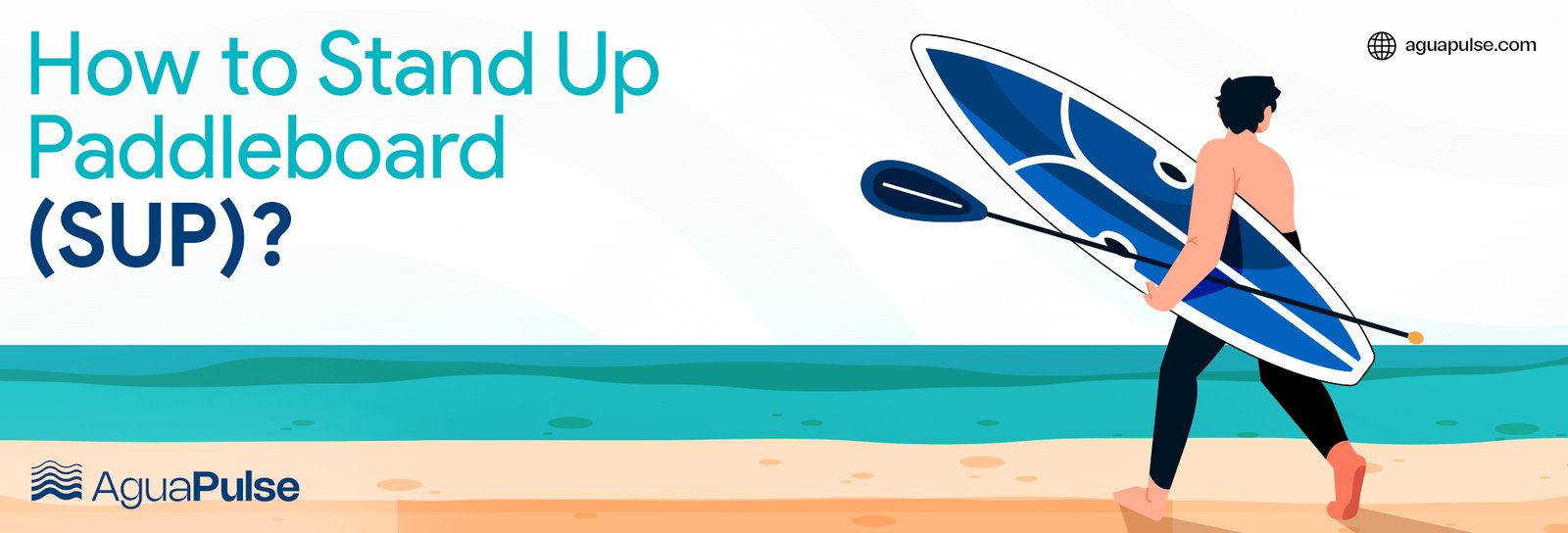Navigate
Are you thinking of trying paddle boarding? Good luck! If you’re worried about falling off your board, wobbling like a penguin, paddling slower than a lazy river, or just plain looking silly. It’s best to stay dry and watch from the shore. But, for those daring enough to make a splash in more ways than one possible, we’ve got some insider tips to transform you from clumsy to confident on the water. Read on if you’re ready to paddle like a pro and leave the fears and possibly a few giggles behind!
Is Paddle Boarding Difficult?
Paddleboarding can seem challenging at first, especially if you’re new to water sports, but most people find it easier with some practice. Here are a few factors that affect the stand up paddle board difficulty:
Balance:
Initially, maintaining balance on the board can take time and effort. However, paddle boards are designed for stability, and once you get the hang of the correct stance, it becomes much easier.
Conditions:
The difficulty can also depend on the water conditions. Calm, flat water is ideal for beginners and makes learning significantly easier. Choppy water or strong winds can increase the challenge.
Physical Fitness:
A basic fitness level helps especially core strength, essential for balance and stability. However, you can be somewhat fit to start.
Equipment:
Using the right size and type of paddle board for your weight and skill level can make a big difference. A wider, longer board offers more stability and is easier for beginners.
Instruction:
Proper guidance or a beginner lesson can dramatically reduce the learning curve. Learning the correct techniques for paddling and balancing from the start can make the process smoother and more enjoyable.
We both know your confidence is already rising if you’ve read this far. With that same motivation soaring, let’s dive into the essential gear to boost your confidence further and ensure you’re well-prepared to tackle the waters like a pro, regardless of the stand up paddle board difficulty you might encounter!
Essential Gear For SUP:
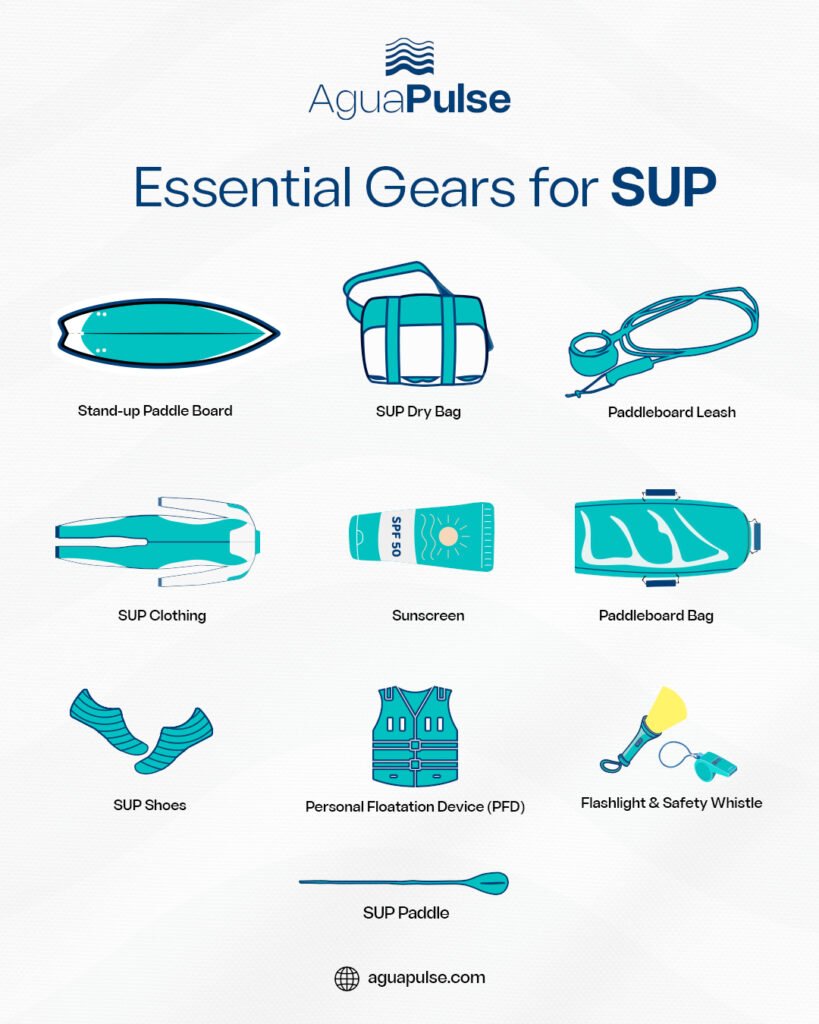
Imagine this: You’ve packed the beach snacks, cranked up the summer tunes, and finally reached the crystal-clear water. You hop on your board, ready to conquer the waves only to realize you forgot something crucial.
Sure, you could wing it (who needs a leash anyway, right?), but wouldn’t a little peace of mind make the whole experience more enjoyable? Here’s the essential gear that separates a fun-filled SUP day from a potential “hold my beer and watch this” moment.
1. Stand-Up Paddle Board: Well, duh! But make sure it’s the right size SUP and type for your activity.
2. SUP Paddle: Unless you plan on using your arms like a frantic windmill, a paddle is kinda essential.
3. Paddleboard Leash: Picture your board drifting happily into the sunset while you doggy paddle after it. Not ideal, right?
4. Personal Flotation Device (PFD): Safety first, friends! Even the most confident swimmers can get caught in unexpected currents.
5. SUP Clothing: Ditch the jeans (trust us) and choose clothes that dry quickly and protect you from the sun.
6. SUP Shoes: Forget the flip-flops! Proper shoes with good grip will save you from a world of ouch (and potential slippery wipeouts).
7. SUP Dry Bag: Don’t let your phone or wallet become a surprise underwater companion. Pack a dry bag to keep your valuables safe.
8. Flashlight & Safety Whistle: Be prepared for unexpected delays. A light and whistle are lifesavers (literally!) if you get caught paddling after dark.
9. Sunscreen: Nobody wants a lobster-red SUP adventure. Apply sunscreen generously and reapply often!
10. Paddle Board Bag: Protect your precious board from bumps and scrapes during transportation. Plus, it looks pretty slick, right?
Now, you’re armed with the knowledge to avoid SUP snafu and maximize your fun on the water! Remember, a little preparation goes a long way in ensuring your paddleboarding experience is unforgettable for all the right reasons.
Types Of Paddle Boards:
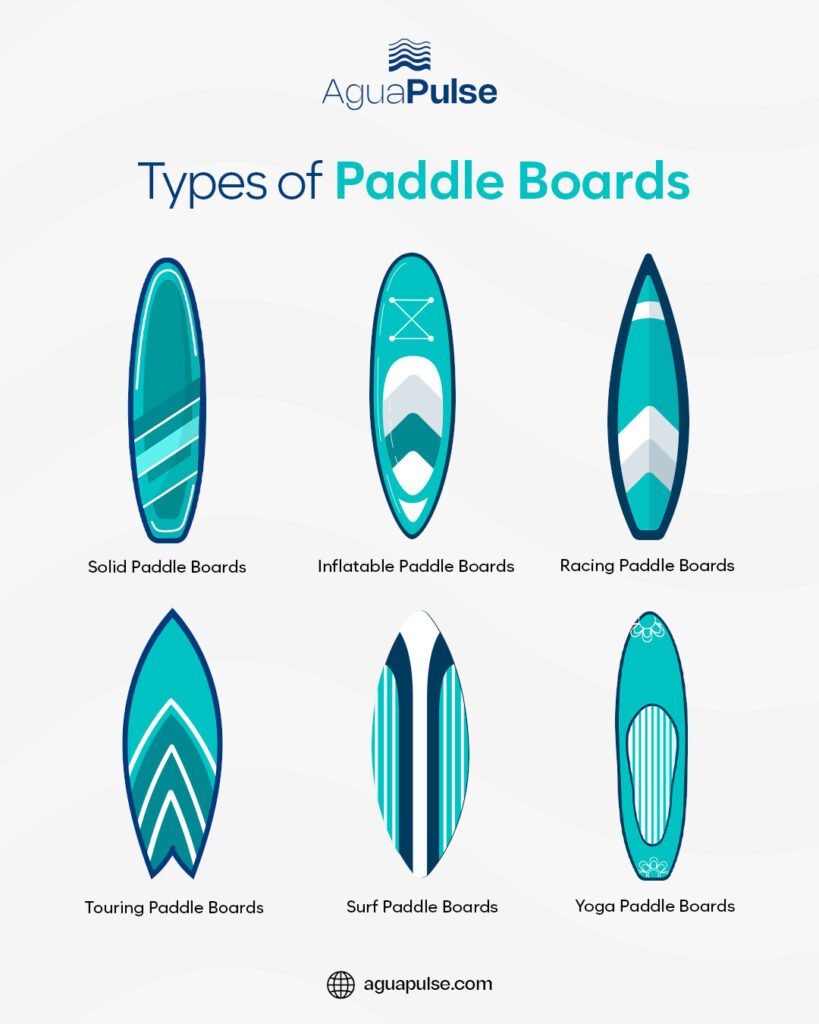
Think all paddle boards are the same? Guess again! Before you write off finding the perfect match, check out our breakdown of the different types of paddle boards. You might just be surprised by what fits your style best!
Solid Stand-Up Paddle Boards:
Solid SUPs are typically crafted with an EPS foam core wrapped in fiberglass and epoxy, creating a durable, lightweight, and relatively affordable setup. For those seeking even lighter options, carbon fiber boards provide a stiffer, albeit more expensive, alternative. Plastic SUPs offer a budget-friendly choice, though they are heavier and perform less effectively compared to other materials. Additionally, some solid SUPs feature exquisite lightweight wood finishes.
Choosing a solid SUP is ideal if performance is paramount; these boards glide faster and with less effort, perfect for those who prioritize speed and distance. They also come in a wider range of sizes and shapes, providing a better chance of finding a perfect fit. The rigidity of solid boards lends itself to greater stability, particularly useful when tackling waves, and their lower position in the water also enhances this effect. However, they require sufficient storage space and a suitable means of transportation.
Inflatable Stand Up Paddle Boards:
In contrast, inflatable SUPs are designed with a PVC exterior and drop-stitch construction that forms a rigid air core when inflated to 12-15 pounds per square inch. These boards are known for their convenience, coming with a pump for inflation and a storage bag for easy transport. Inflatable SUPs excel in versatility and portability, making them ideal for those with limited storage or who frequently travel.
Whether taking a plane or heading to a remote lake, an inflatable SUP is effortlessly packed and transported, even on long hikes. They are also more suited for challenging conditions like whitewater, as they better withstand impacts with rocks and logs. Moreover, for enthusiasts of SUP yoga, inflatable boards offer a slightly softer surface, which is more comfortable for performing yoga poses, blending functionality with comfort.
SUP Types By Use:
Understanding the types of standup paddle boards is crucial as it ensures you choose a board suited to your needs, skill level, and environment. Without this knowledge, beginners may end up with a board that’s difficult to handle, potentially leading to a frustrating experience, slower learning, and increased risk of accidents. Proper board selection enhances safety, performance, and enjoyment, making the sport more accessible and enjoyable.
Touring Paddle Boards:
Touring paddle boards are specifically designed for those who seek adventure and long-distance paddling. Characterized by their longer, narrower shape, touring boards excel in providing speed and glide efficiency, making them perfect for covering large distances over flat or open waters. These boards typically feature a pointed nose or bow, which helps to slice through the water smoothly, reducing drag and allowing for a faster and more energy-efficient ride.
They also often come equipped with additional features such as tie-downs for securing gear, making them ideal for multi-day expeditions. The streamlined design not only enhances performance but also improves tracking, keeping the board straighter on long journeys. Perfect for adventurers and long-distance enthusiasts, touring paddle boards offer a unique blend of speed, stability, and storage capacity.
Fishing Paddle Boards:
Fishing paddle boards are designed to cater to the needs of anglers seeking mobility and access to water bodies. These boards are typically wider and more stable to accommodate standing for long periods and the movement associated with casting and reeling in fish. Enhanced stability also helps in managing the extra weight from fishing gear, coolers, and catches.
Many fishing paddle boards come equipped with features like built-in rod holders, tackle boxes, and accessory mounts, making it easier to organize and access equipment. Some even have specially designed hulls for better tracking and maneuverability in various water conditions. This makes them an excellent choice for those looking to combine the tranquility of paddle boarding with the excitement of fishing.
Racing Paddle Boards:
Racing paddle boards are engineered for speed and performance, making them the ideal choice for competitive paddlers and those who love fast-paced water activities. These boards are distinguished by their long, narrow design and sharp, pointed nose, which collectively reduce drag and enhance hydrodynamics, allowing for rapid movement through the water. Typically constructed from lightweight materials like carbon fiber, racing paddle boards provide an optimal balance between durability and speed.
Their streamlined shape helps maintain straight tracking and efficient glide, crucial for racing scenarios. Moreover, they often feature a minimalistic design with very few additional attachments to keep the weight low and the speed high. This focus on speed and efficiency makes racing paddle boards perfect for those serious about paddle sports competitions or improving personal speed records on the water.
Yoga Paddle Boards:
Yoga paddle boards are specifically designed to provide a stable and spacious platform for practicing yoga on the water. These boards are typically wider and thicker than standard models, offering enhanced stability which is crucial for maintaining balance during various yoga poses. The top surfaces of yoga paddle boards are often textured or softly padded to provide a comfortable, non-slip surface that mimics a traditional yoga mat, facilitating better grip and comfort during exercises.
The calmness of being on the water adds a meditative quality to the yoga practice, making it a uniquely serene experience. These boards also frequently include features like anchor points to hold the board steady in gentle currents or breezes. Perfect for combining fitness and peace, yoga paddle boards allow enthusiasts to merge their yoga routines with the natural tranquility of aquatic environments.
Fitness Paddle Boards:
Fitness paddle boards are designed to enhance workout routines by combining the challenges of balance and strength training with the joys of being on the water. These boards are generally wider and more stable than typical paddle boards to accommodate a variety of exercises, from Pilates to cross-fit style workouts. Stability is key as it allows for movements such as squats, push-ups, and even high-intensity interval training without excessive wobbling.
The deck of a fitness paddle board often features a soft, textured surface to provide traction and comfort, supporting vigorous activities and reducing the chance of slips. Some models include resistance bands or attachment points for fitness equipment, enhancing the workout possibilities. Fitness paddle boards offer a dynamic way to boost core strength, flexibility, and overall fitness while enjoying the scenic views and calming effects of water environments.
Surf Paddle Boards:
Surf paddle boards are uniquely designed to blend the thrill of surfing with the versatility of paddle boarding. These boards are typically shorter, thicker, and have a narrower tail compared to traditional paddle boards, allowing for greater maneuverability and responsiveness in wave conditions. The rocker, or the upward curve of the board’s nose, is more pronounced in surf paddle boards to help manage the dips and rises of ocean waves, preventing the board from nosediving and facilitating smoother rides on the surf.
Surf paddle boards often feature a grippy deck pad that extends toward the rear to secure footing during dynamic movements and turns. Their construction is also robust to withstand the impact of waves and frequent use in saltwater. Ideal for paddlers who want to carve through waves while standing up, surf paddle boards offer a challenging and exhilarating way to engage with the surf.
SUP Paddling Techniques For Beginners:
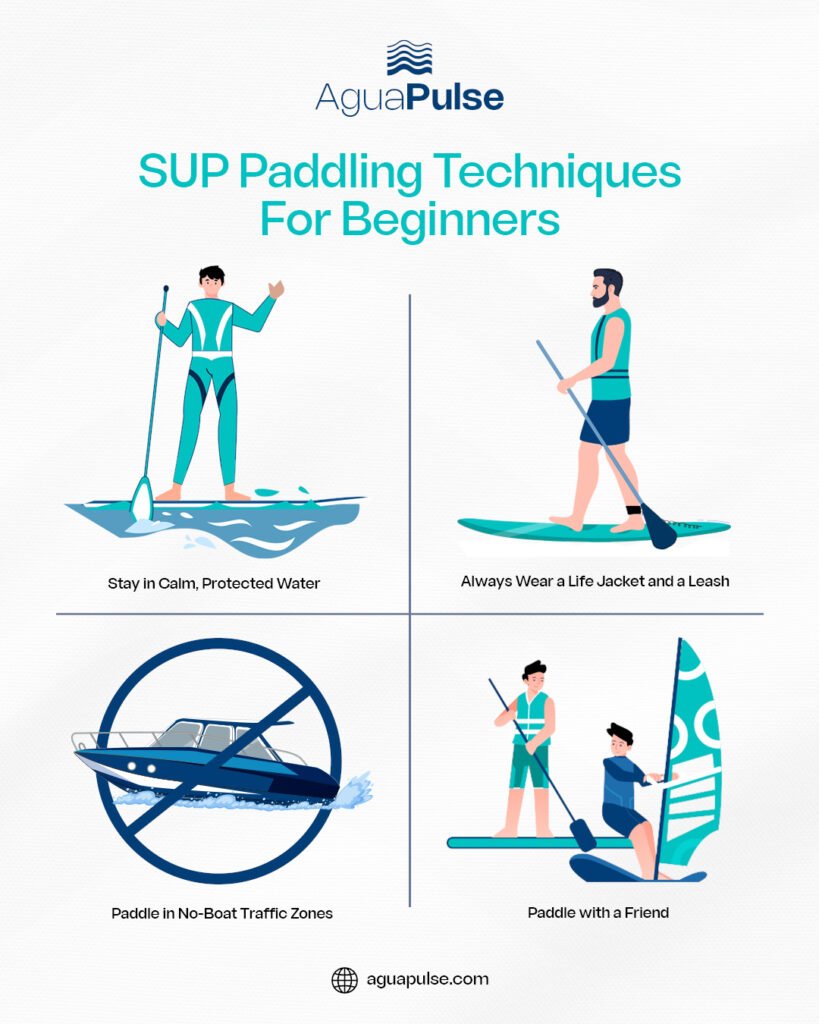
Mastering the right SUP paddling techniques from the start is crucial for any beginner. It’s not just about getting moving, it’s about moving right. Proper technique, including the correct paddleboard stance, ensures you paddle efficiently, conserving energy and minimizing the risk of injury. Without this foundational knowledge, you’re likely to develop bad habits that can lead to strain and discomfort, potentially souring your experience.
Additionally, understanding how to handle various water conditions and maintain a proper SUP stance can prevent accidents and increase your confidence in the water. Start your paddle-boarding journey with the correct techniques and SUP stance, and you’ll enjoy a smoother, safer, and more rewarding experience from your very first stroke.
Safety Techniques For SUP:
For beginners, adhering to safety protocols is essential to ensure a positive and secure stand-up paddleboarding experience. Following these safety protocols not only ensures your physical safety but also enhances your confidence on the water, making your paddleboarding experience enjoyable and stress-free. Here are some key safety tips to follow:
Stay in Calm, Protected Waters:
When starting out, choose environments such as small lakes, calm bays, or quiet rivers that are sheltered from strong currents and winds. These conditions make it easier to maintain balance and control, providing a safer learning environment.
Always Wear a Life Jacket and a Leash:
Safety gear is non-negotiable. A life jacket will keep you afloat in case of a fall, and a leash attaches you to your paddle board, ensuring it doesn’t drift away if you end up in the water. This is crucial for both safety and convenience.
Paddle in No-Boat Traffic Zones:
Areas free from boat traffic reduce risks associated with waves and collisions. It allows you to focus on practicing your skills without the worry of navigating around faster, larger vessels.
Paddle with a Friend:
Always try to paddle with a companion. This not only makes the activity more enjoyable but also safer. Having someone nearby means immediate help is available in case of an emergency.
Choosing the Right Paddle Size Being A Beginner:

Choosing the right paddle size is a fundamental step for beginners in stand-up paddleboarding, as it directly impacts comfort, efficiency, and overall performance on the water. Selecting the right paddle not only makes your introduction to paddleboarding more enjoyable but also helps prevent strain and injury, allowing you to focus on mastering the technique and enjoying the experience. Here’s how to select the appropriate paddle size:
Measure for Height:
The general rule for determining the ideal paddle length is to add 8 to 10 inches to your height. This ensures that the paddle is long enough to propel you effectively without causing you to overreach, which can lead to fatigue and imbalance.
Adjustability:
For beginners, an adjustable paddle is a great choice as it allows for experimentation with different lengths to find what feels most natural. This flexibility can accommodate changes in your paddling style and the types of water conditions you encounter.
Consider the Blade:
The size and shape of the paddle’s blade also play a crucial role. Larger blades deliver more power but can be more tiring to use, while smaller blades are easier to handle and are better for longer paddling sessions. Beginners might start with a medium-sized blade to strike a balance between power and ease of use.
Material and Weight:
Lightweight materials such as carbon fiber or fiberglass are easier on the arms and shoulders, making paddling less strenuous. Although these materials can be more expensive, they are worth considering for the added comfort and control they provide.
Leash Application For Beginners:
Using a leash is a critical safety measure for beginners in stand-up paddleboarding, ensuring that you stay connected to your board if you fall into the water. Using a leash correctly not only keeps you safe but also builds confidence as you learn, knowing that your board will always be within reach. This is vital for managing energy and focus when learning to paddle and maintaining safety in various water conditions. Here’s how to properly apply and use a leash:
Put on Your Leash Before Entering the Water:
It’s essential to secure your leash before you approach the water. This prevents the board from drifting away if you lose your balance and fall as you get on or encounter strong currents.
Placement on Ankle or Calf:
The leash can be attached around your ankle or calf based on personal preference and comfort. Ankle leashes are common and generally offer ease of attachment and detachment. Calf leashes can be preferable for those who might need to move the leash out of the way for activities like surfing or racing, providing easier access and adjustment.
Getting on the SUP Board as a Beginner:
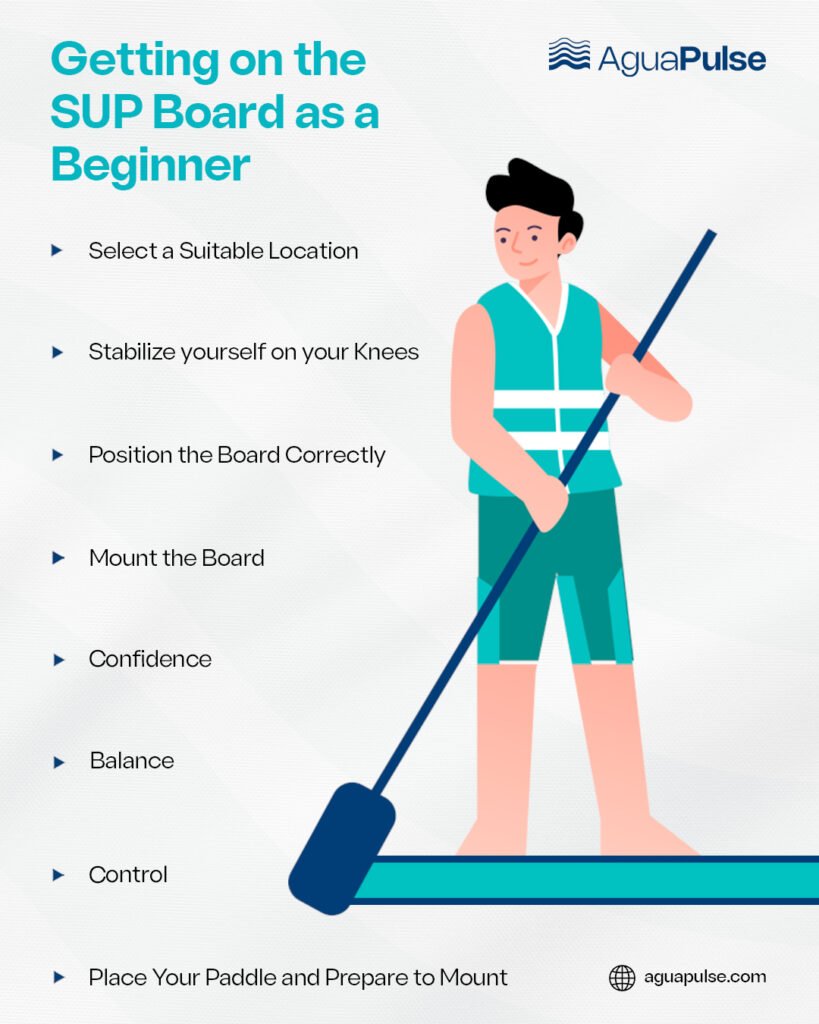
Getting on a paddle board for the first time can be a challenging but exciting experience. Once you feel balanced and comfortable on your knees, you can attempt to stand up slowly, using the paddle for support. This step-by-step approach helps manage the learning curve and increases safety and enjoyment as you begin your paddle-boarding adventures. Here are detailed steps to help beginners confidently mount their board:
Read: How To Stand On Paddleboard? to Proper SUP Stance.
Select a Suitable Location:
Start by finding a spot where the water is deep enough so that the fin on the bottom of your board doesn’t catch on the bottom. This prevents damage to your board and ensures you can start smoothly.
Position the Board Correctly:
Turn the board so that it is parallel to the shore and wade out into water that is deeper than the length of your fin. This positioning helps stabilize the board as you prepare to mount it.
Place Your Paddle and Prepare to Mount:
Lay your paddle across the board just in front of the carry handle. This placement keeps your paddle within easy reach and stabilizes it as you get on the board.
Mount the Board:
Step next to your board and place your knees on either side of the carry handle, which is typically the balance point of the board. Gently push away from the shore with your hands to start moving into deeper water.
Stabilize Yourself on Your Knees:
Before attempting to stand up, stay on your knees and focus on three key things:
Balance:
Feel the board’s response to your movements and maintain your weight centered over the board. This is the foundation of a proper SUP stance.
Control:
Handle your paddle while kneeling, using it to steer and stabilize yourself as needed. This initial paddleboard stance helps you get comfortable before transitioning to a standing position.
Confidence:
Build your confidence by moving gently and feeling the stability of the board under you.
Kneeling position (kuìzī)
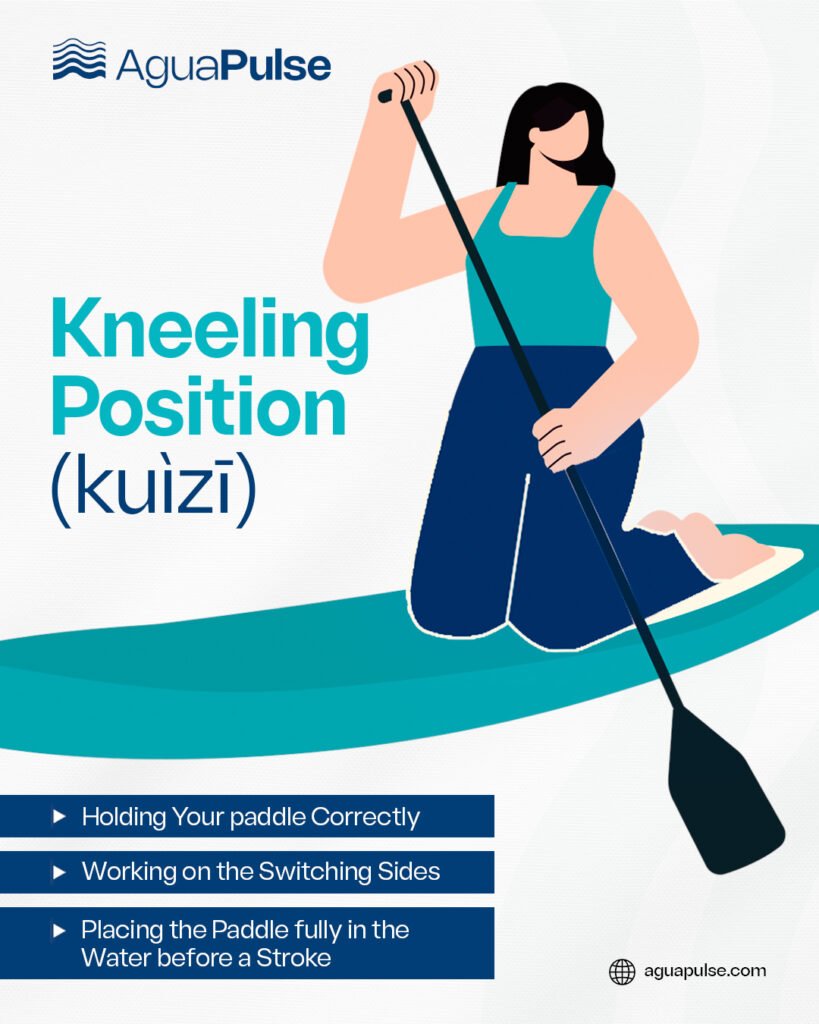
Adopting the correct kneeling position, or kuìzī, on a paddle board is a fundamental skill for beginners, providing a stable base from which to develop paddling techniques. Mastering these aspects of the kneeling position will enhance your stability, control, and efficiency on the water, making your paddle-boarding experience more enjoyable and effective.
This position also serves as a stepping stone to standing up and paddling, as it builds foundational skills in balance and paddle handling. Here’s how to effectively utilize the kneeling position:
Placing the Paddle Fully in the Water Before a Stroke:
While kneeling, ensure that you submerge the paddle blade fully into the water before each stroke. This technique maximizes the efficiency of your stroke by capturing the most water, providing better propulsion and control. It also helps maintain balance by ensuring consistent, strong strokes.
Working on Switching Sides:
To maintain a straight trajectory and balance, it’s important to alternate paddling on both sides of the board. Practice smoothly switching the paddle from one side to the other. This not only helps in steering but also in developing even muscle strength and coordination. Start by paddling a few strokes on one side, then switch to the other, gradually reducing the number of strokes between switches as you get more comfortable.
Holding Your Paddle Correctly:
Hold your paddle with the blade canted forward, toward the nose of the board. This orientation of the blade increases the water catch and helps drive the board forward more effectively. Many beginners mistakenly hold the paddle backward, which can reduce propulsion efficiency and make steering more difficult.
Standing Up On A Sup Board As A Beginner:
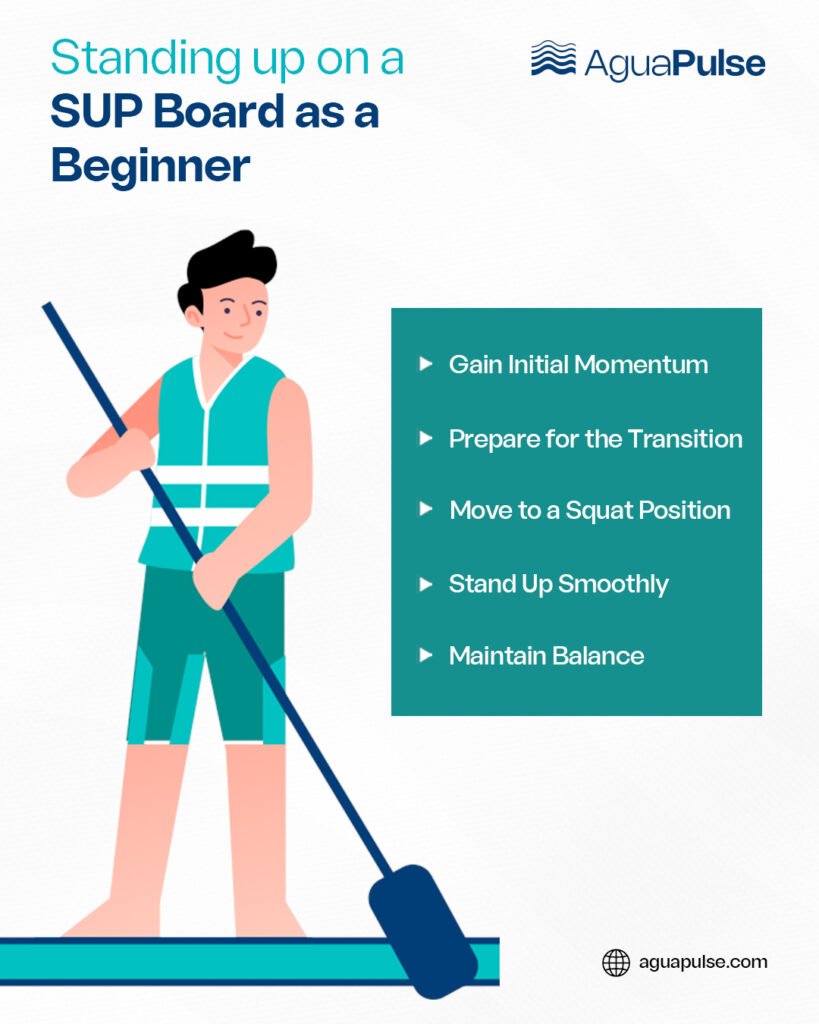
By following these steps, beginners can smoothly transition from kneeling to standing on a SUP board, ensuring a stable and enjoyable paddling experience. Standing up on a SUP board for the first time can feel daunting, but with these step-by-step instructions, beginners can rise to a standing position with confidence and stability:
Gain Initial Momentum:
While still on your knees, take a stroke or two with your paddle. This action will help you gain some momentum, making the board more stable and easier to manage as you transition to standing.
Prepare for the Transition:
Place your paddle horizontally across the board in front of you. This stabilizes the paddle and frees up your hands for the transition. Ensure you are looking straight ahead towards the horizon, not down at your feet. This helps maintain balance.
Move to a Squat Position:
Shift from your knees to a squatting position. During this movement, place your feet flat on the board where your knees were, positioned roughly shoulder-width apart around the center line of the board. Keep your back straight to maintain a strong, balanced posture.
Stand Up Smoothly:
With your feet firmly and flatly planted, begin to rise to a standing position. As you come up, quickly grab your paddle and get the blade back in the water for a stroke. This will help stabilize you immediately upon standing.
Maintain Balance:
Stand up and position yourself in the center of the board. Bend your knees slightly and keep your feet parallel, about hip-width apart. This forms the foundation of your SUP stance. Engage your core by tucking your tailbone under, and keep your gaze forward. This balanced posture will help you stay stable and react to the water’s movements.
Paddling techniques for efficiency:
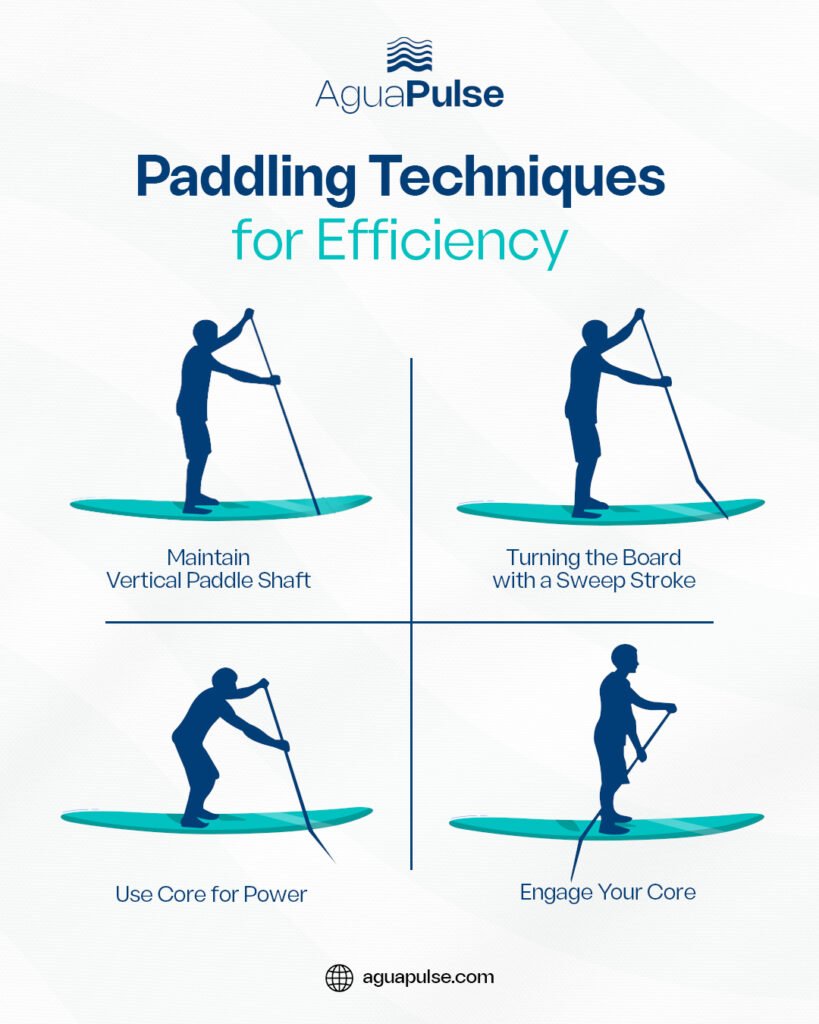
Efficient paddling techniques are crucial for maximizing performance and endurance while stand-up paddleboarding. By mastering these techniques, you can enhance your paddling efficiency, allowing for longer sessions on the water with less fatigue. This approach not only improves your paddling but also contributes to a better overall SUP experience. Here’s how to paddle more efficiently using proper techniques:
Maintain Vertical Paddle Shaft:
Keeping the paddle shaft vertical during strokes helps ensure that the force you apply is directed downwards, propelling you forward more effectively. Avoid letting the paddle drift toward the tail of the board, which can waste energy and reduce propulsion. A vertical shaft also helps in maintaining a straighter course, reducing the need for corrective strokes.
Turning the Board with a Sweep Stroke:
To change direction or turn the board, use a sweep stroke. This involves angling the paddle at about 45 degrees away from the board and sweeping it in a wide arc from the nose to the tail. This wide stroke leverages the water’s resistance against the paddle to efficiently turn the board in the opposite direction of the stroke.
Engage Your Core:
Instead of relying solely on your arms, engage your core, hips, and shoulders when paddling. Start by rotating your shoulders to extend the paddle forward for a deep, effective catch in the water. As you pull the paddle back, rotate your hips and shoulders in the direction of the stroke. This full-body engagement distributes the workload across larger muscle groups, increasing power and endurance while reducing fatigue in your arms.
Use Core for Power:
The core is your center of strength. By using your abdominal muscles to power through each stroke, you not only increase stroke efficiency but also protect your back and reduce the risk of injury. Ensure that each stroke is powered by a twist from your core rather than just pulling with your arms.
Coming back to shore:

Returning to shore safely and efficiently is an essential part of stand-up paddleboarding, especially for beginners. By following these steps, you can come back to shore smoothly and safely, preserving both your safety and the integrity of your paddle board. Here’s how to manage this process:
Squat Drop to Your Knees:
As you approach the shore and the water becomes shallower, it’s important to lower your center of gravity to maintain stability and avoid falling. Before you get too close to the shore, transition from standing to a squatting position, and then drop down to your knees on the board. This position will prevent you from potentially falling as the water depth changes.
Paddle on Your Knees:
Continue to paddle towards the shore while on your knees. This position provides greater stability and control as you navigate the shallower waters near the shore. It also reduces the risk of damaging the fin if the water is too shallow for standing paddling.
Let the Nose Run Up on Shore:
As you reach the edge where the water meets the shore, allow the nose of the board to gently run up onto the shore. This helps stabilize the board and prevents it from floating away as you disembark. Keep the board’s rail (side) slightly lifted with the support of the water, which helps in smoothly transitioning out of the water.
Grab the Handle and Walk Up Out of the Water:
Once the nose of the board is securely on the shore, reach for the central carry handle of the board. Firmly grasp it, step off the board, and walk it up out of the water. This method ensures that you maintain control of the board and avoid any damage or undue stress on the equipment.

